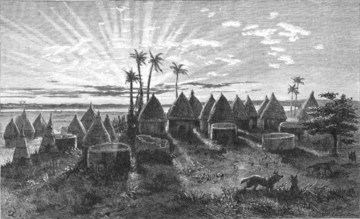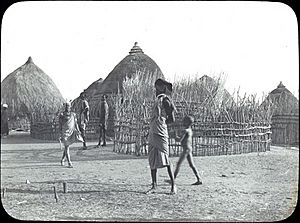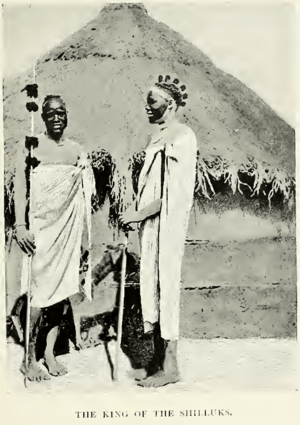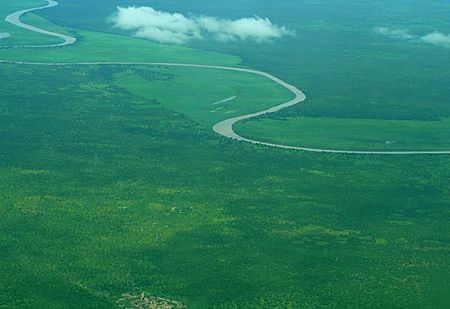Shilluk Kingdom facts for kids
Quick facts for kids
Shilluk (Chollo) Kingdom
Läg Cøllø or "Pödh Cøllø" or "Sudan" in Arabic
|
|||||||||||
|---|---|---|---|---|---|---|---|---|---|---|---|
| 15th century–1861 | |||||||||||
|
Flags
|
|||||||||||
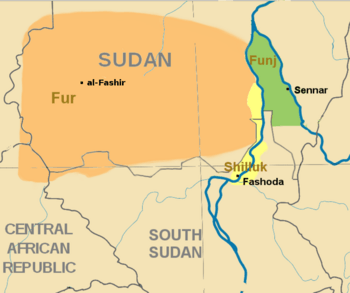
Shilluk Kingdom (yellow) and its neighbors
|
|||||||||||
| Capital | Fashoda (from the late 17th century) | ||||||||||
| Largest city | Fashoda | ||||||||||
| Common languages | Shilluk | ||||||||||
| Religion | Imperial cult African Traditional Religion |
||||||||||
| Government | Divine monarchy | ||||||||||
| Rädh | |||||||||||
|
• 1490–1517
|
Nyikaangø | ||||||||||
|
• 17th century
|
Odaagø Ocøllø | ||||||||||
|
• 17th century
|
Rädh Tugø | ||||||||||
| Historical era | Late medieval to early modern period | ||||||||||
|
• Established
|
15th century | ||||||||||
|
• Disestablished
|
1861 | ||||||||||
| Population | |||||||||||
|
• (1900s)
|
200,000 (est) | ||||||||||
|
|||||||||||
| Today part of | South Sudan Sudan |
||||||||||
The Shilluk Kingdom was a powerful kingdom in Africa. It was located along the White Nile river in what is now South Sudan and southern Sudan. Its capital city and home for the king was Fashoda.
The kingdom was founded by a legendary hero named Nyikang. This likely happened in the late 1400s. The Shilluk people are part of the Nilotic group, who live near the Nile River. They were the only Nilotic group to create a strong, centralized kingdom.
The Shilluk Kingdom was strongest in the late 1700s and early 1800s. Later, in the 1800s, it faced attacks from the Ottoman Empire. This led to the kingdom's downfall in the early 1860s. Today, the Shilluk king is a traditional leader, not an independent political ruler. The current king is His Majesty Reth Kwongo Dak Padiet, who became king in 1993.
The Shilluk king, called the Reth, was both a political and religious leader. People believed his health was connected to the health of the whole nation. They performed rituals inspired by the stories of Nyikang, their first king.
Contents
Where was the Shilluk Kingdom located?
The Shilluk Kingdom stretched along the western and eastern banks of the White Nile and Sobat rivers. It went from Lake No up to about 12 degrees north latitude.
The Shilluk people are related to other groups in South Sudan, like the Nuer and Dinka. Their language, Shilluk, is similar to the language of the Anuak people. The name "Shilluk" comes from the Arabic version of their own name, Cøllø or Chollo. This suggests they might share a common origin with the Acholi in Uganda.
Like most Nilotic people, the Shilluk raised cattle and farmed grains. Cattle were very important to them. They lived in settled villages because the land near the White Nile is very fertile. They grew a type of millet called durra, which helped them be successful farmers. In the 1800s, about 200,000 Shilluk people lived in hundreds of villages. The kingdom was divided into two main areas: Gher in the north and Luak in the south. These areas were then split into smaller zones.
History of the Shilluk Kingdom
How the Shilluk Kingdom began
Shilluk stories say the kingdom started around 1490. The first legendary ruler was Nyikang. He was said to be half-crocodile and could control the rain. Nyikang was the son of a king named Okwa. After Okwa died, Nyikang fought his brother Duwadh for the throne. When Nyikang was losing, he left his homeland with his followers.
They traveled northeast to a place near the Bahr el Ghazal River. Nyikang married the daughter of a local magician there. After some disagreements, Nyikang and his group moved north again. Legends say that Nyikang disappeared in a whirlwind during a battle.
The kingdom's growth and challenges

Early border conflicts
In the 1600s, the Shilluk often raided nearby groups along the White Nile. This helped them get more resources. The Shilluk king (Reth) also led these raids. He used his armed men, called Bath Reth, to gain more land and power.
Around 1600–1635, King Odak Ochollo tried to expand the kingdom's northern border. He made an alliance with the Sultanate of Darfur to control trade on the White Nile.
In the 1600s and 1700s, the Dinka people moved into areas south and west of the Shilluk kingdom. The Shilluk and the Funj people then worked together to stop the Dinka. This time also marked the start of the Shilluk trading with other groups, like Arabs and Europeans.
The Golden Age of the Shilluk monarchy
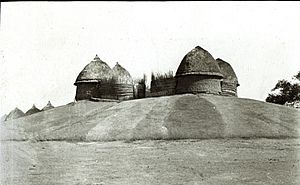
After 1650, the Shilluk people became more united. The king's power also grew stronger. The king and his government took control of trade and resources. This was largely due to the military success of King Dhokoth (around 1670–1690). Raids continued into Dinka lands and the Nuba Mountains.
In 1684, a drought caused crops to fail. Many Shilluk men went down the river to raid Arab areas for food. During this time, the White Nile was even called the "river of Shilluk." King Tugø (around 1690–1710) made Fashoda the permanent home for the Shilluk kings. He also created special ceremonies for kings.
The Shilluk Kingdom was at its strongest in the 1700s. At this time, the Funj Sultanate was losing power. The Shilluk kings took advantage of this to strengthen their northern borders. They controlled trade routes and helped merchants cross the White Nile. The Shilluk Kingdom even expanded its land up to where Khartoum is today. They successfully fought off many invasions from northern groups.
Decline and restoration
In 1786, the Funj Sultanate began to weaken. In 1820, Muhammad Ali, the ruler of Egypt, began to conquer Sudan. His troops ended the Funj Sultanate. This made a conflict between the Ottomans (Turkish-Egyptian troops) and the Shilluk unavoidable.
Starting in 1821, the Shilluk's northern border began to shrink. The first confirmed slave raid into Shilluk land happened in 1826. After this, the kingdom was often attacked by raiders. During the reign of King Reth Nyokwejø (around 1780–1820), a combined force of Dinka and Nuer crossed the Sobat River. This caused the Shilluk to lose full control of the White Nile.
By 1865, the Shilluk Kingdom had lost much of its political power. Today, the Shilluk (Chollo) Kingdom is part of South Sudan and Sudan. The current Shilluk King is Reth Kwongo Dak Padiet, who became king in 1993.
Shilluk Culture and Society
Social structure
Lineage (Kwa)
The word Kwa means "grandfather" or "ancestor." Kwaarø and Kwari mean "grandchild" or "descendant." These words are used for "lineage" and "clan" in Shilluk. Members of a Kwa come from the same ancestor. For example, Kwar Okëëlø means all the descendants of Okëëlø. There are over 100 known lineages.
Some examples of Kwa include:
- The Kwa Ajalø, founded by Jalø, who was with Nyikang.
- The Kwa Mønø, founded by Mønø, a servant Nyikang met.
- The Kwa Ju, founded by Ju, Nyikang's half-brother.
- The Kwa Tugi, founded by Tugø, a spirit Nyikang found in a river.
- The Kwa Tuga, founded by Tuga, an Arab whose sister married Nyikang.
Grouping (Pödhø)
The pödhø refers to a group of villages. Several lineages live in these villages and unite for protection under one leader. This group of villages is the basic unit of Shilluk society. There are over 100 pödhø in the region.
In the past, these lineages would unite during tribal wars. But in times of peace, they sometimes broke apart due to internal conflicts. People often felt torn between their podh leader and their Kwar leader.
Originally, Nyikang gave each lineage its own podh as a home. If this lineage still exists, its members are called dyil and are considered the land owners. Other lineages who moved there later are called wëdhdh. If the ruling dyëll family dies out, the land rights go to the next oldest lineage in the area.
Hamlet (Pajø)
Inside each podh are hamlets, called pajø. A pac is where people from the same lineage live. Some hamlets might have only one house, while others have more than fifty. A pajø is like a large family. A traditional home has two huts, called gol, with a small space between them. The homes are built around a common area for goats and cows. A larger hut, lwagø, is used for livestock during the rainy season. The rest of the year, it's a place for guests and meetings.
Family (gølø, or "kalø" gool)
The word gol or "kalø" also means "family." The gol is the smallest unit in Shilluk society. An unmarried man does not have his own home. He lives with his father or his oldest married brother if his father has passed away. The head of the house is responsible for everyone living there and for the family's cattle. If someone in the family commits a wrong, the head of the family is responsible for paying for it, usually with cattle.
Social classes
The Shilluk people were divided into four main classes.
Kwareth
The Kwareth is the royal clan. Its members are descendants of Nyikang. This group is spread out, and its male members traditionally had many wives. Even though they don't have political power today, they are seen as a type of rural nobility. Members hold one of four titles:
- Reth: The king, who inherits the throne from his father.
- Nyireth: A prince or princess. If male, they are next in line for the throne.
- Nyareth: The son of a nyireth.
- Kwar Nyireth: The son of a lesser nyireth.
Ororo (Ororø)
The Ororø are a branch of the royal family who lost their place in the line of succession. They are similar to other people, but they have special roles in royal ceremonies.
A story tells that during King Odaagø's rule, the Shilluk lost a battle. It was decided that all princes would fight the next day. All the princes were killed except for Prince Duwadh. Duwadh became king and made all the sons of the dead princes part of the Cøllø class. Since then, only Duwadh's descendants could be in the Kwar Reth class. Those who were demoted were called Ororø, meaning "son of a crowd of young girls."
Chollo (Cøllø)
This class includes most Shilluk clans and the majority of the Shilluk people. Its members are descendants of Nyikang's relatives, his companions in exile, or people from other groups who settled in Shilluk country. For example, the Kwa'Jängø clan was originally a Dinka clan. The Kwa'Mööyø are originally Nuer descendants in the Shilluk Kingdom.
Bang Reth: Bangng Rädhø
The Bang Reth is the class belonging to the king. It has two groups: the king's wives and the widows of past kings. The second group includes people who were like servants. These were descendants of slaves captured in raids or people who sought the king's protection after committing a serious crime.
Religion and Mythology
The Shilluk people, like other Nilotic groups, focus their beliefs on a legendary figure: King Nyikang. His origins are considered divine.
The story of Nyikang
A white cow named Dean Aduk gave birth to a gourd. From this gourd came a man named Kolo. Kolo had a son named Omaro, who had a son named Wat Mol, who then had a son named Okwä.
Okwä was said to have seen two beautiful young women, Nyakayo and Ongwak, coming out of a river. They had long hair and part of their bodies were like crocodiles. Okwä took them by force. Their screams alerted their father, Dunyel Ju'Okwa, who was nearby. Dunyel was a man on his right side and a crocodile on his left. After talking, Dunyel agreed to give his two daughters to Okwä for a high bride price. Nyakayo gave birth to several children, including Nyikang. Some say Nyikang was her oldest son, others say her youngest. Another story says Nyikang had a twin brother named Duwat. Many people believe the place where the Sobat River meets the White Nile is where Nyakayo lived.
Nyikang's journey
When Okwa died, Nyikang and his brother Duwat fought over who would be king. Duwat became king, but Nyikang refused to accept him. Nyikang decided to leave with his family.
As Nyikang was leaving, Duwat threw a sharp stick at him. This was a sign that Nyikang and his followers could never return. But Nyikang picked up the stick and used it to plant crops.
After many days of travel, Nyikang's group arrived in a land ruled by a sorcerer named Dim. Nyikang married, and his wife had a son named Dak. The group settled near where the Sobat River flows into the White Nile. This is where they founded the Shilluk Kingdom.
Images for kids
See also
 In Spanish: Reino shilluk para niños
In Spanish: Reino shilluk para niños




